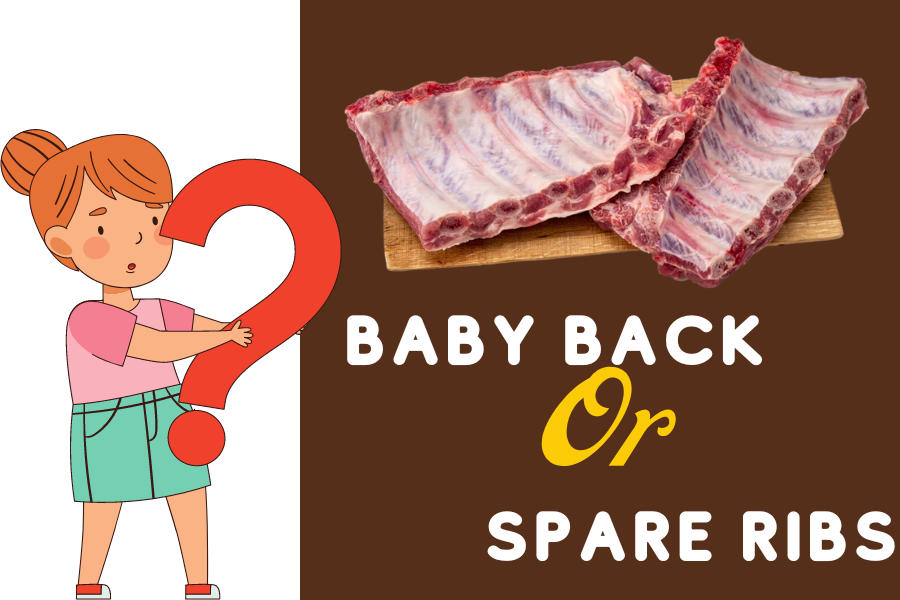Baby Back Vs Spare Ribs – A Clash Of Culinary Titans
If you’ve ever found yourself contemplating which type of rib to choose for your next BBQ gathering. There are two popular cuts that often come to mind: baby back ribs and spare ribs. Understanding these differences can help you choose which type of ribs to cook and how to prepare them.
In this exploration of baby back ribs versus spare ribs, we will differentiate the flavor profiles, tenderness, cooking techniques, and ideal preparations for each type of rib.

ANATOMY AND CUT
Understanding anatomy and cuts plays a crucial role in differentiating their size, shape, and characteristics.
Baby Back Ribs: These come from the pig’s back ribs, and they are called “baby” back ribs because they are shorter and narrower compared to spare ribs. It has a more curved, C-shape appearance, making it visually appealing. The meat on baby back ribs is relatively leaner with a higher meat-to-bone ratio. Baby back ribs are considered to have a slightly sweeter flavor and a more tender, less chewy texture.

Spare Ribs: come from the pig’s belly area and are larger and meatier than baby back ribs. They have a rectangular shape with a flatter and straighter bone. Spare ribs contain more fat, connective tissue, and cartilage, which means that they require a longer cooking time. The bones of spare ribs are longer, flatter, and wider, resulting in a more significant meat-to-bone ratio.
Both baby back and spare ribs can be prepared in a variety of ways, such as dry rubs, marinades, or smoked. It’s all about taste and how you like your meat cooked when deciding between baby back and spare ribs.
FLAVOR PROFILE
Let’s explore the flavor profiles of baby back ribs and spare ribs:
| Aspect | Baby Back Ribs | Spare Ribs |
| Flavor | Delicate and subtle | Rich and intense |
| Meatiness | Lean with less fat marbling | More fat marbling and connective tissue |
| Tenderness | Very tender | Tender, but requires longer cooking time |
| Texture | Moist and tender | Juicy and slightly chewy |
| Fat Content | Lower fat content | Higher fat content |
| Flavor Absorption | Absorbs flavors well | Absorbs flavors and smoke intensely |
| Best Cooking Method | Grilling, baking, or smoking | Smoking, braising, or slow cooking |
| Preferred Seasoning | Versatile; complements many rubs | Bold and robust seasonings |
| Culinary Use | Elegant presentation | Hearty and indulgent eating experience |
COOKING TECHNIQUES
There are several different cooking techniques that are well-suited for both baby back ribs and spare ribs. Here are some popular cooking methods suited for each rib cut:
Baby Back Ribs
Grilling: Baby back ribs are well-suited for grilling due to their tenderness. Baby back ribs can be grilled over direct heat for a shorter period of time to retain their tenderness and develop a delicious charred exterior.
Baking: Baking baby back ribs is another common method. Cook low and slow, resulting in tender, juicy ribs.

Spare Ribs
Smoking: The higher fat content and connective tissue benefit from the extended cooking time. Which allows the fat to render and the collagen to break down, resulting in tender ribs. Braising: This technique helps break down the connective tissue, resulting in fall-off-the-bone tenderness. Braising spare ribs involves slow-cooking them in a liquid, such as broth or barbecue sauce
Mastering the chosen cooking technique and choosing it depending on personal preference, will delight your taste buds.
For optimal tenderness and safety, ribs should be cooked to an internal temperature of 195 to 203 degrees Fahrenheit, which must be monitored continuously while cooking regardless of method.